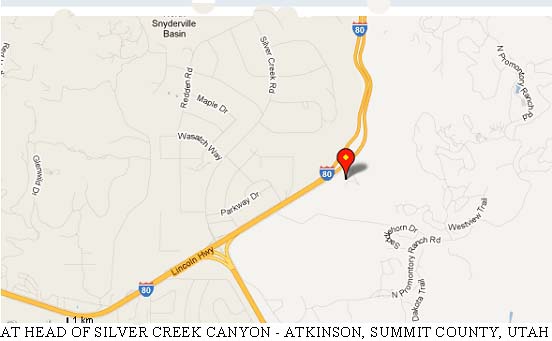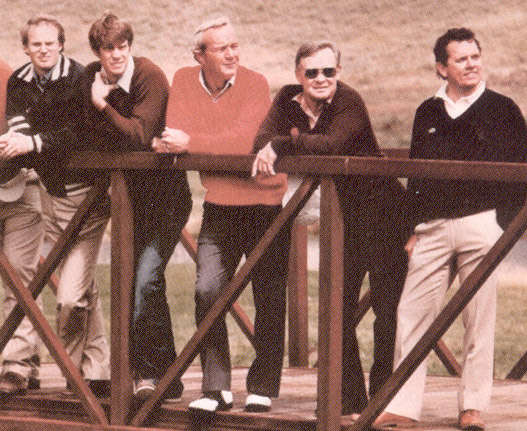-NW Summit County People & Events
NW Summit County People & Events
Summit County, Utah Driving Tours
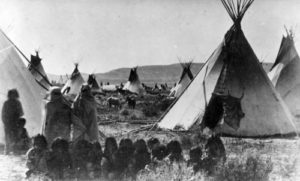
Hundreds of years before the white man entered this area Shoshone Indians camped near Hoytsville. Northern Shoshone and Ute Indians lived in Summit County. The high mountain summits that form the divides of the Weber, Bear, Provo, and Green River drainages contain 39 of Utah’s highest peaks, this is why the county of Summit received its name.
Fur trappers and traders first came through the county starting in the 1820s. Jedediah Smith, Jim Bridger, and Kit Carson all camped at the numerous springs near Peoa. In 1825 William Ashley’s party of trappers rode across the Kamas Valley to the Weber River, and on to Echo Canyon and Wyoming.
1700-1845 – There are indications that Spaniards and Mexicans explored Utah and Summit County. The 1776 Dominguez-Escalate expedition was one such group. Other explorers in the region included Jedediah Smith in 1826 and John C. Fremont in 1844. The Indians called this area “Hole in the Sky.” One trapper-explorer, Miles Goodyear, purchased a Mexican Land Grant in 1845 that extended to northern Ogden. Indicating the range of the early Mexican explorations.
1847 – Brigham Young and the Mormon settlers pass through what is now northwest Summit County on their way to the Salt Lake Valley. Captain James Brown along with wife Mary McRee Black Brown, and others from Mormon Battalion detachment [Company C] who had wintered in Pueblo, Colorado met up with Young just before they arrived at the view site of the Salt Lake Valley.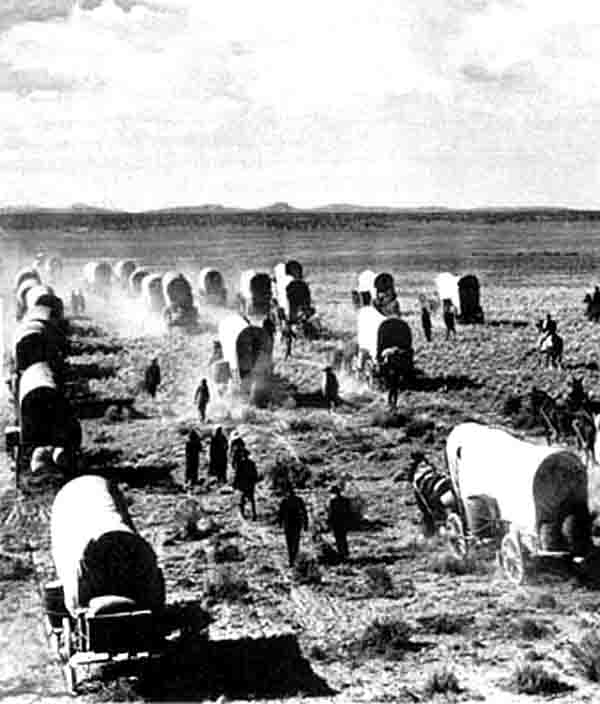
1847 – Kimball Brothers Stage Line operates between Park City and Salt Lake City through the heart of today’s Swaner Preserve, establishing Kimball’s Junction. Photo dated July 1847.
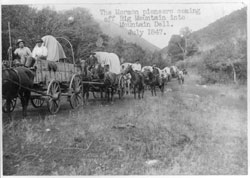
1848 – Beginning on June 30, 1848, Parley Parker Pratt rode up Canyon Creek Canyon (now Emigration Canyon), crossed over Little Mountain Summit and descended into the North Fork of Big Kanyon (sic) Creek (now known as Parley’s Canyon). He then proceeded past what is now Lambs Canyon and crossed over the summit into the very large high mountain meadow, a basin shaped area called a “park”, which forms the head waters of East Canyon Creek. This high meadow basin soon became known as “Parley’s Park.” Upon his return to Salt Lake Valley, Pratt reported to Brigham Young that there was much timber and grazing lands in the vicinity. He also reported that 16 to 20 miles distant from Great Salt Lake City, there were suitable sites for the quarrying of sandstone as a building material. Parley Pratt also recommended to the church High Council that they appoint a formal exploration party to look into the possibility of building a road through the canyon; an action which was immediately taken.The early pioneers brought their cattle to graze the abundant grass. Between 1847-1850 Parley Parker Pratt, opened a toll road “the Golden Pass route” between Parley’s Park City and the Salt Lake Valley, collecting tolls from westerly travelers en route over the mountains to the California gold fields. Two years later Pratt sold his toll road to finance another mission calling.
 Around 1850 – Samuel Comstock Snyder, (1808- Heber Chase Kimball, and Jedediah M. Grant secured a land grant from the territorial government (other accounts state “squatter’s rights” from Parley P. Pratt) to settle this valley. The area was soon home to brothers Samuel Snyder and Chester Snyder and their families. The Snyder brothers were polygamists and soon 150 people were living in the community of Snyderville. Samuel Comstock Snyder and his first wife, (1) Henrietta Mariah Stockwell Snyder, and their 14 children: Permelia Snyder, George Franklin Snyder, Mary Ann Snyder, Ephriam Stockwell Snyder, Laura Altha Snyder, Henrietta Snyder, Amy Snyder, Robert Hyrum Snyder, Sarah Jane Snyder, Isaac Snyder, Betsy Ann Snyder, Charles Wellington Snyder, Annice Lovica Snyder, and Jaddiah Snyder, were the first settlers in the Silver Creek area, and gave their name to the community that grew up in this meadow, now known as the Snyderville Basin. Samuel Snyder’s five wives were: Henrietta Mariah Stockwell, Caroline Little Luce, Susan Clarissa Harden Williams, Louisa Josephine Williams, Nancy Ann Perks. Chester Snyder’s five wives were: Catherine Montgomery, Malinda Wilcox Wood, Electa Murdock, Harriet Knight, Sally Snyder. The geographical location of Park City and the collection of miners’ tents had been known as Upper Parley’s and Upper Kimball, after the prominent Mormon leaders, Parley Parker Pratt and Heber C. Kimball.
Around 1850 – Samuel Comstock Snyder, (1808- Heber Chase Kimball, and Jedediah M. Grant secured a land grant from the territorial government (other accounts state “squatter’s rights” from Parley P. Pratt) to settle this valley. The area was soon home to brothers Samuel Snyder and Chester Snyder and their families. The Snyder brothers were polygamists and soon 150 people were living in the community of Snyderville. Samuel Comstock Snyder and his first wife, (1) Henrietta Mariah Stockwell Snyder, and their 14 children: Permelia Snyder, George Franklin Snyder, Mary Ann Snyder, Ephriam Stockwell Snyder, Laura Altha Snyder, Henrietta Snyder, Amy Snyder, Robert Hyrum Snyder, Sarah Jane Snyder, Isaac Snyder, Betsy Ann Snyder, Charles Wellington Snyder, Annice Lovica Snyder, and Jaddiah Snyder, were the first settlers in the Silver Creek area, and gave their name to the community that grew up in this meadow, now known as the Snyderville Basin. Samuel Snyder’s five wives were: Henrietta Mariah Stockwell, Caroline Little Luce, Susan Clarissa Harden Williams, Louisa Josephine Williams, Nancy Ann Perks. Chester Snyder’s five wives were: Catherine Montgomery, Malinda Wilcox Wood, Electa Murdock, Harriet Knight, Sally Snyder. The geographical location of Park City and the collection of miners’ tents had been known as Upper Parley’s and Upper Kimball, after the prominent Mormon leaders, Parley Parker Pratt and Heber C. Kimball.
1852 – Around this time Wanship became Summit County’s first county seat where the first courthouse was built. The State Legislative Assembly voted to divide the Utah Deseret Territory into twelve counties. In 1854 they created a new county, Summit County. Between 1854 and 1880 the size and shape of our county changed several times until Utah became a state in 1896.
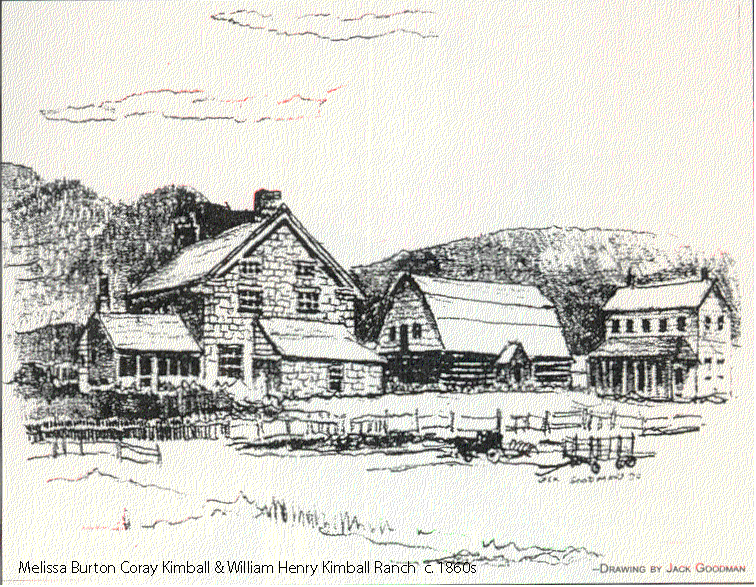
William Henry Kimball (1826-1907) (See “The Forgotten Son -WHK” by Marlin K. Larsen}- another early settler in Parley’s Park. He started a stagecoach business in 1854, vying with Brigham Young’s X-Y Express for the federal mail contracts. His business was interrupted when Pres. Young called him to serve a mission for the Mormon Church to England 1854-1857. After his return, around 1860 or 1862 William built the Kimball Hotel and Overland Stage Stop in Parley’s Park, a place well known for many years to travelers on the “Old Overland Pony Express” mail route, and eventually the route was part of the coast to coast Lincoln Highway.. William lived most of the time in Salt Lake City with his first wife Mary Davenport. He married his second wife on December 24, 1851, the widow of William Coray. Melissa Burton Coray Kimball (1828-1903) and her seven children were the resident proprietors of the Kimball Hotel. Melissa ran the store, hotel and post office at Kimball Junction in Summit County, Utah for many years until they sold it c.1868 to Mr. Sellars. William served as the Postmaster (Melissa taking on the daily duties), leaving the actual work in Melissa’s care. The hotel was a massive eleven room structure constructed of native stone, at a cost of $10,000, nails and materials being so costly. It stands today near Kimball’s Junction north off I-80 at 1318 Bitner Road. This station, run by Melissa Burton Coray Kimball, was visited by the likes of Mark Twain, Walt Whitman, and Horace Greeley. The area is still known as Kimball Junction. Still standing, it is the oldest permanent building in Summit County.
1853 – John Dixon (1818-1853) and John Quayle (1833-1853) were killed by Indians on August 7, 1853. John Hoaglund was wounded. Jesse Johnstun escaped by running all the way up Spring Canyon, over the mountains into Salt Lake City. President Brigham Young ordered the settlers to build a Fort which they did northeast of the Snyder mill. Some homes were inside, and at night the cattle, wagons and equipment wee brought inside. At other times the Indians would set fire to several piles of lumber, so Mr. Snyder resorted to hiding the lumber in high grass and in ditches.
George Gideon Snyder (1819-1887 or 1901) Samuel Snyder’s brother, lived in the Basin meadow a short time before going further south in 1872, living with his seven wives and children, into the “Park” and naming and settling that area known as “Snyder’s Addition” a name that continues to identify these plats. The Addition George homesteaded would be bounded by today’s Heber Avenue and Kearns Boulevard, he subdivided the land and platted it. In 1883 George sold all the remaining plats to David McLaughlin for $2,000.[number of lots?] McLaughlin was part of the ‘Michigan Bunch’ with holdings of the very lucrative Marsac Silver Mining Company.
George Snyder’s wives were Sarah Wilder Hatch (1843), Elsie Pamelia Jacob (1854), Caroline Kilfoyle (1856), Martha Kilfoyle (1857), Rhoda Shadwell Orchard (1864), Rebecca Snyder, and Rachel Winter Tanner (1864)(D).
Chester Comstock Snyder (1815-1888) – son of Isaac Snyder and Lovisa Comstock, brother of Samuel Snyder, brought his third wife Electa Murdock (1841-1887) to Parley’s Park, they were the first couple to remain here and be buried here at Snyder’s Cemetery.
Ephraim Stockwell Snyder (1831-1904) son of Samuel C. Snyder and Henrietta Stockwell, husband of Elizabeth McNaughton, also settled in Parley’s Park.
Besides the many hardships of pioneer life, these people suffered from the severe cold and deep snow, being deeper than could be found in the other intermountain regions. The growing season was short and often crops did not mature. If traveling in the winter and not near any protection from the weather at night time, it was necessary to keep moving the livestock so they wouldn’t freeze to death. [During one Silver Springs winter in the 1980’s one or more of Doc Osguthorpe‘s cows were reported to have frozen to death in the meadows off East Meadows Drive.]
The native meadow grass grew and was cut by scythes and stacked for winter feeding. The valley was a natural for cattle raising and the dairy business. The L.D.S. Church ran a dairy farm on the location of Silver Springs for over a hundred years. The other important local industry was lumbering.
1860 – Summit County was created from the existing Green River and Great Salt Lake counties. Summit County was named from the fact that it included 39 of Utah’s highest peaks along the Wasatch Mountain range. In 1861 the county began to be organized, and soon became noted for its mineral resources, gold, silver, lead, copper, coal, iron, and mica.
1860 – Construction of a road through Silver Creek Canyon began. The later extension of this road replaced the major route through Three-Mile Canyon. In May William Henry Kimball and two wives, (20) Melissa Burton Coray and (3) Martha Jane Vance moved their families to Parley’s Park.
In 1860 there were approximately 150 members of the L.D.S. Church in Parley’s Park. Jesse W. Johnstun (1820-1860 or 1866) married to Samuel C. Snyder’s daughter Betsy Ann Snyder in 1848, became the Presiding Elder and conducted any business or meetings. On the 6th of May 1860 Jesse was accidentally killed in the Snyder saw mill. [Thanks to 4G grandson, Joseph Johnstun for confirmation of this date.]
In June of the same year Ephraim S. Snyder was called to preside over the Saints by William W. Cluff, the Presiding Bishop in Summit County. Ephraim, Chester, Jake Workman, and Joseph Black were the trustees for the first schoolhouse, a small log building in the heart of Snyder’s Village, located north of where Jim Murnin lives today.
1864 – William Atkinson, George Pace, William Moss, and Orin Hatch moved their families from Bountiful to Parley’s Park where they homesteaded the land at the head of Silver Creek Canyon. These men established a large dairy and raised beef and sheep. This settlement became known as Atkinson, Utah.
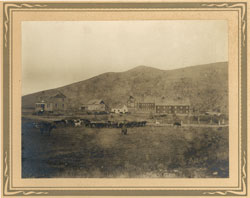
Atkinson, Utah – short-lived ore-town
1865 – George Milton Pace bought out Atkinson, Moss, and Hatch who were feeling overcrowded. Pace established the Silver Creek Livestock Company on nearly 1,000 acres of meadowland to support his family of 14 children. The Pace Dairy supplied meat, dairy products, and produce to mine and railroad workers. William Henry Kimball became postmaster at the Kimball Ranch.
1866 – Thomas E. Jeremy Sr. of Carmarthenshire, South Wales joined the Mormon Church in 1846 and traveled aboard the Buena Vista to America, and then to Utah. His son, Thomas Evans Jeremy, Jr. (1839-1925) and his wife Elizabeth Petit Jeremy (c1925-1919), parents of thirteen children (seven of whom survived infancy), built a stone cabin in northwest Summit County. There the family raised hay and a herd of nearly 10,000 sheep that were wintered at the west end of Salt Lake City at 2450 West 3300 North along the Jordan River. Thomas told advantage of The Homestead Act of 1862, signed into law by President Abraham Lincoln, provided applicants with 160 acres of land. One stipulation was that the recipients live on the land six months of each year. Around 1890, the Jeremy family used the revenue from their other businesses to increase their land holdings to over 20,000 acres just east of Parley’s Summit extending nearly to what is now known as Kimball’s Junction.
While living in Salt Lake City, Thomas Jeremy was elected as city councilman. He co-founded the Cambrian Society, a society to preserve a love and interest in the Welsh culture. Thomas built the first shallow salt crystallization pools and refinery. His Jeremy Fuel & Grain Company delivered salt, grain, and coal from Carbon County, to customers along the Wasatch Front. Ethan John Jeremy (1869-1948) continued his father’s business interests, particularly the expansion of the Jeremy Ranch in Summit County. Ethan’s son, Thomas Ethan Jeremy (1904-1979) was the last of four generations to own and operate the Jeremy Ranch as a successful sheep enterprise.
1868 – In late October, soldiers climb over the mountains from Big Cottonwood Canyon to the Park City area and find silver. As the snow is swirling and a storm brewing, they mark the outcropping with a bandanna on a stick and return in the spring. The first mine is named Flagstaff. Park City will become known not only for its silver, but for lead, zinc and gold. The Flagstaff Mine is the first to ship ore from the area.
1869 – The Transcontinental Railroad is completed at Promontory, Utah. Laid-off workers, including many Chinese, settle in Parley’s Park.
On July 9, 1877, both the Parley’s Park Ward and the new Summit Stake were organized. They covered a large area, and many groups of settlers. As far as Parley’s Summit on the west , to Atkinson’s and Pace’s Junction on the east, to Kimball’s Junction on the North, endless boundary on the south, which included Park City’s Mining Camp. George Snyder’s family was the only L.D.S. family there this early.
Joseph H. Black – was the first Bishop of the new Parley’s Park Ward in 1877, but only served one year because of moving to the Vernal, Utah area.
Alexander H. Stanley – served as Bishop during 1878-1881. During his tenure John Taylor took over the Presidency of the church after Brigham Young’s death. A new schoolhouse was built, funds from taxation. It was 22 X38 feet. (This was also used as a Meetinghouse). The location was further south on the bend of the Highway, near a store run by Pace and Archibald. Their customers being miners en route to Park City.
1879 – July – The L.D.S. Church built the Utah Eastern Railroad between Coalville and Kimball Ranch.
The 1880 Census showed Parley’s Park Precinct had 314 people, 24 families, 26 homes. Snyderville had 291 people,59 families, 35 homes.
1880 – Union Pacific Railroad purchased part of the land owned by George M. Pace to build the Atkinson Station freight stop for the Echo and Park City lines. Twenty-six large stockyard pens were built to contain the herds of sheep and cattle in preparation for transporting. Herds were driven there from areas like Snyderville and Heber City. These pens can still be seen from I-80 on the south side as drivers enter Silver Creek Canyon.
1881– George Milton Pace – was Bishop from 1881-1897, the year of his 60th birthday he died at Atkinson, Summit, Utah. He was married to Sarah Alvira Standley, they had fourteen children. Bishop Standley moved from the area in 1881.
Another saw mill was built at the mouth of White Pine Canyon by William Gibson. Sam Snyder’s saw mill had been closed.
In 1883 a new meetinghouse was built, at the cost of $1,200. The funds raised by the Bishopric. A rustic building 28 X 18 feet located further north where the State Highway Road Dept. buildings stand today, only closer toward the hills. There is a natural spring there, and this is where they would get water for the Sacrament. A Parley’s Cemetery was started there, but you can find graves out closer to the Highway, not in the Cemetery, maybe because of weather they were unable to take and bury the deceased into the higher elevation. The Church Meetinghouse was centrally located for Gorgoza members and other Parley’s Park members. In 1910 Heber J. Grant, a General Authority, visited. He made two strong suggestions. 1. Move this building away from this cold spot. 2. Put glass in the windows. The people were so poor that they had put cloth or other coverings over some of the windows as they had done in their own homes and barns.
Wilford Woodruff was now President of the L.D.S. Church in Salt Lake City. At long last Utah is a state, no longer a territory.
1888 – Over 100,000 sheep grazed in Coalville and East Canyon area, originally owned by the William Kimball family, subsequently owned by Milton Bitner, then Eaton and son Tom Jeremy, and the Gillmor families.
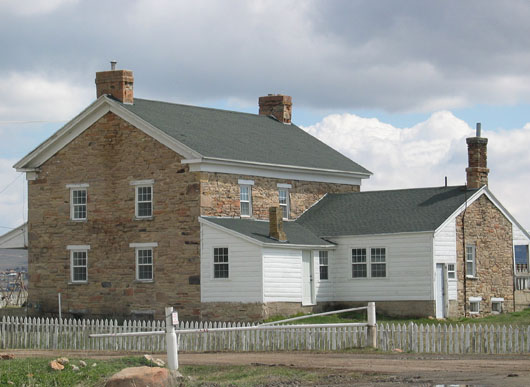
Bitner house on north side of I-80. In 2003 the Stone House became part of the Swaner Nature Preserve.
1889 – – John W. Young – son of Brigham Young, promoted and saw the Utah Central railway built up Parley’s Canyon, a difficult and costly labor. The first completed train tracks connected Salt Lake City and Park City along East Canyon Creek, past Kimball Junction, along what is now I-80. “Parley’s Canyon Utah Central” included a trestle over Lamb’s Canyon that frightened most passengers and kept some from riding the train, it included a tunnel and many sharp turns.
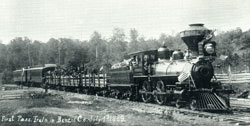
After John Young had borrowed all of the money he could possibly get in this country for the costly railroad, he went to Europe where he succeeded in interesting a Spanish nobleman, Don Rodriquez Velasquez de la Gorgoziandus (spelling varies, also Gorgozada), in the new railroad to the immensely rich mining camp of Park City. John told Gorgoziandus of the great metropolis that would be built and promised to name it for him –Gorgoza. He got the million and half and kept his promise as the name Gorgoza at Summit Park proves. Utah Central railway completes the first train tracks connecting Salt Lake City to Kimball’s Ranch to Coalville running along East Canyon Creek and through what is now Swaner Preserve commencing to the Park City station now known as Robert Redford’s Zoom Restaurant. Elder Andrew Jenson, a Church General Authority visited Parley’s Park. He described it as a beautiful area, with a group of worthy Saints. (Park City area no longer part of Parley’s Park area, They are now being organized into their own Ward.)
Some pioneers in the Gorgoza area include Eaton (Ethan) Jeremy and his son Tom Jeremy. They owned a very large tract of land. Part of the Jeremy Ranch went to the now improved dirt road State Road 65 in East Canyon along Mormon Flat. They would need to hire 2- to 30 young men each summer to work their large livestock business. They built one of the lovelier homes in the area, known as the Jeremy Ranch House, which has been kept intact and moved into Snyderville on Old Ranch Road when the Interstate Highway cut into the area. Jack Gallivan of the Salt Lake Tribune newspaper restored it and used it to entertain international friends and his family.
The railroad was really a boon to travel and transporting all kinds of merchandise into Salt Lake and needed supplies back up the canyon. Besides farm and dairy products, there was the famous “Stoven Ice House’ located north of the Kilby home on the creek next to the railroad. Ice ponds between Gorgoza and Parleys Park along East Canyon Creek and at Kimball Junction provided a harvest of ice. Here ice was cut during the winter and stored in an Ice House, probably in coal slack and sawdust, then in summer shipped on the train into Salt Lake City, for the ready market there. Also school students traveled into “the new schoolhouse” which had just been built – 2 rooms on Old Ranch Road, and near the railroad tracks. One half mile from Snyder’s Junction. The railroad crossed the valley in a north and south direction where the large sewer system was installed in 1979, the tracks were removed in the early 1940’s. This schoolhouse was used by all students until school buses were started, taking the students into Park City.
Early settlers in lower Parley’s Canyon were Mitchell‘s and Roach‘s, who started a rest stop known as the “Half-way House”. Some of their buildings still stand in the area of Mountain Dell Golf course today. Roach sold to Bob Lee.
1889 – The town’s population is over 5,000. The city is one of the first in the state to have electric lights.
Hans O. Young – Bishop from 1887-1901–The records show increased activity in the Gorgoza area in Parley’s Summit (c.3863 Kilby Road). Hans is credited with ownership of a ranch at Kimball Junction that included the stone house and barn at 5683 S.R. 224 known as the Wallin farm, now (2011) owned by the Swaner Nature Preserve.
1892 – Silver King Mine is incorporated. It will prove to be one of Park City’s largest producers of silver.
1892 – Jens Peter Krouse Rasmussen was born on 12 OCT 1858 in Soften, Aarhus, Denmark. He died on 19 DEC 1922 in Park City, Summit, UT.– Krouse homesteaded in 1892 in this area. He married Kristina Maria Phillipsen, was born on 12 June 1856 in Egga, Randers, Denmark. She died on 3 September 1925 in Park City. They had a family of 7 boys and one girl.All of them attending school in Gorgoza.
http://freepages.genealogy.rootsweb.ancestry.com/~porters/database/d204.htm#P45
Children were: Christian Richard Kruse RASMUSSEN, Bodil Marie Rasmussen, Erastus Lehrman K RASMUSSEN, James Royberg Kruse RASMUSSEN , Orson K RASMUSSEN, Andrew K RASMUSSEN, Aaron Krouse RASMUSSEN, Osmond K RASMUSSEN (twin), Osmer K. RASMUSSEN (twin) .
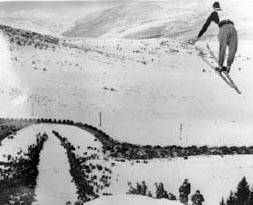
Ralph Bistila of Ishpeming, Michigan flies from Ecker Hill, Summit County c.1915-1920 or 1949.
One son, Christian Richard Kruse Rasmussen was born on 27 MAR 1881 in Brabsand, Aarhus, Denmark. Chris worked for the Jeremy Ranch, and once through extreme exertion injured his heart.He was bedridden for months an in later-life he had limited health.Chris fulfilled a mission to Denmark and on his return married Elsie Marie, a convert from Norway.Chris was helped by Mr. Jeremy in buying 160 acres of land.In the following winters’ snow this couple started skiing. It was natural for Scandinavian Christopher Rasmussen and his wife Elsie Marie to want to teach their children to ski. Using trees cut on their property, Chris constructed a steeple jumping scaffold and used it as a ski jump (this may be the reason that Ecker’s Ski Jump was built in the same area several years later)and opened the ranch to skiers, installing one of the first rope tows in the West. By 1927, the new ski area was hosting Salt Lake high school ski clubs. Chris died on August 4, 1935, leaving 3 sons and one young daughter, Selma Rasmussen, and his widow Marie.
Selma married James B. Kilby (July 1921-Feb 2009) on December 8, 1941. In 1945 Jim and Selma bought the “Welcome Inn Cafe.” In 1961 James was appointed as the Park City precinct Justice of the Peace for Summit County. He held that position until he retired in 1987. James Kilby also served on the Park City Board of Education, was a charter member of the Summit County Planning Commission, and the Snyderville Basin Sewer District Board, and served as the Park City Judge for many years. James and Selma had two children, Lisa Kilby (Keith) Tumelson, and Larry Kilby (married Kathleen)
1893 – Because silver is no longer to be used to back currency, silver prices drop. Miners at the Silver King accept a pay cut from $1 to 50 cents, allowing the mine to continue operating while others remain closed. First drilling contest takes place. In 15 minutes Frank Ward sinks his drill 17.5 inches into the rock. Yearly contests continue to this day as part of Miner’s Day (Labor Day) festivities.
1894 – George Milton Pace and wife Sarah Standley Pace with their 14 children.
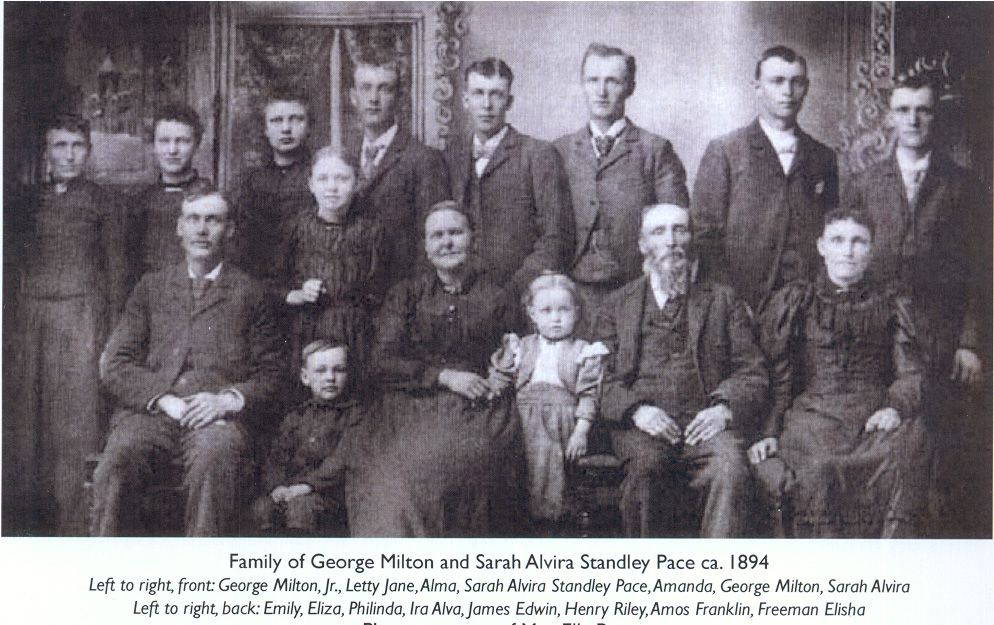
1896 – On statehood day, January 5, Park City has a population over 7,000.
1897 – The Pace Family Dairy and Ranch was divided into fourteen sections following the death of George M. Pace. James Alma Pace and Freeman Pace bought out their siblings’ shares to continue two separate ranching and dairy operations.
1898 – Park City population approaches 10,000. In June, 200 of the 350 structures, homes and businesses burn in the worst fire Park City has ever seen. Three quarters of the town is gone, 500 are homeless, $1 million in property is lost. Gone is the grand new opera house built at a cost of $30,000 and open less than three months. Seventeen volunteers leave to fight in the Spanish-American Way which forces the price of silver upward.
1899 – The town is rebuilt in one and a half years! The new buildings are more substantial – many are built of brick and stone to withstand fire. George Wanning’s saloon is the first to be rebuilt.
1901 – Angus J. Cannon – was Bishop between 1901-1916. He lived with his family in a big rock house in the heart of Snyderville. This home had as its later owners, Gene Cannon, Hugh J. Joseph, R.H. Fletcher, and Lou Felton. Rock houses were now being built because of the many sandstone quarries in the surrounding mountains. The rock was also being shipped by train to Salt Lake City and being used in road building.
1902 – July 15 – Thirty-four men from the Daly West Mine die in an explosion of a large underground store of dynamite, which also produces fatal fumes. Considered the worst mine disaster in Park City history, the event prompts adoption of a state law forbidding the underground storage of large amounts of explosives.
William Henry Kimball Ranch was sold to Brigham Sellers.
1904 – The Miners Hospital is built for the sum of $5,000 raised by local businessmen and the Western Federation of Miners Local #144. Six thousand miners are treated for “Miner’s Con”, or silicosis, in the first year.
1906 – One of the first skiers in the area, “Bud” Wright spends the winter on skis troubleshooting as a lineman for the telephone company between Alta, Brighton and Park City.
1907 – Hard times befall the town, with cave-ins and flooded tunnels making mining a poor enterprise. The panic of 1907 affects the whole United States, causing a general recession. However, the economy improves by the end of 1908.
William Henry Kimball died on December 30th at age 81 years. He is buried in Coalville Cemetery, later joined by his fifth wife Naomi Eliza Redden and her two daughters Zoe and Ida.
1908 – Big Four Exploration Mill purchased land from the Paces to build a huge mine mill that processed around 1,000,000 tons of tailings carried down by Silver Creek. The mill hired hundreds of workers who all settled in the new company town called “Big Four”. Four entrepreneurs, two engineers familiar with the new milling techniques and two geologists arrived in Atkinson with the idea of recovering the now valuable tailings.
1909 – George J. Stahle, , answered a newspaper ad that Stoven‘s Dairy and Ice House (aka Spring Creek Ranch, now addressed as 6598 Glenwood Dr.) had placed, they needing a herdsman.He worked for them a year, then hired out to Bishop Cannon, who helped him buy 80 acres at 995 Old Ranch Road from Mr. Payne.He married and raised his family here.His son Elmer Stahle was living on the property where there are two homes. The mother, Bertha Stahle, lived a long, active life until the winter of 1979. She died on her 97th birthday.
1910 – A one-room school house was built by the South Summit School District for the growing number of children in Atkinson. The Union Pacific Railroad built a freight depot and three large bunkhouses for its section crews.
1911 – E.J. Beggs (contractor for the Summit County Courthouse) was hired to construct the Miller Mill on the outskirts of Park City, the area is now known as Prospector Square, to process the large quantity of tailings deposited there by Silver Creek stream.
1911 – George Sweeney Pace was born and died in 1911 in Summit County. He was buried in a little known patch of ground near the Chevron pumping station located on the southwest corner of Kimball Junction. This area is rumored to have two or three groups of graves, one group of Indian graves, one for the local early Pace family, and another not identified. This cemetery dates later than the Snyder Cemetery at Bear Hollow. Another headstone records the birth and death of Clyde Elisha Johnson born and died on December 5, 1933. Clyde was the son of Irvin William Johnson (son of Clyde Linton Johnson and Jennie Syvilla Noll Johnson) and Vera Pace Johnson (daughter of Freeman Elisha Pace and Minnie Isabell Sweeney Pace).
On the southeast corner of Snyderville Center (Old Ranch Road and Highway 224), lived the Dan Sorenson family.His son Jim Sorenson also built a new home there.Next to them Will Durant (Bishop of Park City Ward), his married son and family were living in the home when a terrible fire early in the morning of December 2, 1958, destroyed the home and killed their four children. Bloom’s live in the new home there now. In 2013 Soaring WIngs Montessori tore down the Bloom’s house and trees to build a new school on the property.
Next would be Dave Loerstcher (Bishop in Park City) who bought property on both sides of the road, from the big property owner Mr. Powers.This today is the Entrance to the Park West Ski Resort. Bishop Loerstcher built the home on the east side of the highway (where Ray Fry built the red brick Park West condos).
Jim Murnin lives today in the Wilford Snyder home, which neighbors what was once known as the “Upper” Fletcher Ranch.R.H. Fletcher had been one of the original settlers, and built the home and barns where Bill Wallin now lives (that is Diane & Bill Wallin who was the Summit County Commissioner for many years in the 1980s and early 1990s). Later Fletcher’s bought extensive acreage from Gillmor’s and Cannons, which was the heart of the Snyder holdings years past, and meant that they owned property on both sides of Highway 224. When Lou Felton, who had been in the area working, married Ellen Fletcher, this couple lived in the old rock house on the upper Fletcher Ranch. This couple are the parents of Beverly Jean Felton Pace who is so active in the Snyderville Ward at this time. (She married Standley Brown Pace of the Pace family in Silver Creek or the Pace-Atkinson Junction mentioned in the NW Summit County People & Events webpage.)
1915 – On July 17, 1915, the Park Record newspaper reported the proposed construction of the Broadwater Mill. “Kirk and Leavell, who constructed the Big Four mill at Atkinson, will make this one a duplicate, but twice the capacity. Life expectancy of these concentrating mills was short: It is expected that it will require two and one-half years to treat the immense tailings dump.” With the completion of the mill construction, workers were hired and soon another big boarding house owned by Japanese immigrant, Mr. Ike Kow was built to accommodate the rapid growth.
1916 – Heavy snows cause fatal snow slides and the collapse of the famed Dewey Theatre (where the Mary G. Steiner Egyptian Theatre now stands) just hours after 300 patrons finish watching the evening movie.
Milton Bitner was Bishop from 1916-1924. He bought the Kimball Ranch and other acreage from a big land owner, Mr. Hoffman, which is still today the Bitner family properties.Bitner became a big sheepman, his sons carried on the same business. Because of the famous Kimball Hotel on his property, as well as another home built, it was a natural place for house guests.President George Albert Smith visited and was a house guest.George Q. Cannon came fishing and hunting and would carry out church assignments while here.Travel by that time was mostly by train.
Full-time missionaries were assigned; they would live with the members, for free room and board. The Bitner’s were their host when they were in the area.
One meeting was held on Sunday “Church”, or better called “Sacrament Meeting”.This at mid-day, giving members from far away travel time.During the winter it was often impossible because of bitter cold and drifted snow.It would be in a sleigh with heavy animal hide robes, and warned bricks around them to keep warm.By this time school students either rode horses or the train to school.The weather prevented children from school so often that in 1924 Bishop Bitner moved his family into Salt Lake City.
During this time an exciting thing happened when he was Bishop.Electricity was brought from Park City.It was a community effort. Wilford Snyder and Dave Snyder (Ephraim Snyder’s sons) dug post holes over mountain from John Mills (now Park Meadows Homes in Park City), down past the Marcellin’s, past Porter’s (later McQuarries) to Bitner’s in 1919.Then on to Stoven‘s, followed the railroad track to Stahle’s, then westward to Snyderville.
1917 – Atkinson, a town in Silver Creek Valley (early USGS maps call it Park City East), had a population of more than 500. This town, an early major Union Pacific Railroad freight and livestock depot, and Big Four tailings processing center, completely disappeared by 1980.
Mountain Dell Dam was constructed, the first large scale damming of East Canyon Creek.
1918 – The great influenza epidemic prompts a law requiring anyone on the streets to wear a thick gauze mask or be arrested. Consequently, the impact of the disease is less severe in this area.
— The Big Four declared bankruptcy and closed its operation. The closure forced nearly all of the families in Atkinson to move away. Atkinson is now referred to as “The Town That Once Was.”
–The Gillmor brothers, Charles Jr. and Edward, began to loan money to local farmers, Freeman Pace, Hyrum and Zina Homer, John and Johanna Clark, and others, using their land and herds as collateral. Eventually, these properties foreclosed to Gillmor ownership.
1920 – Skiing becomes more widespread as some workers take the mine train to the top of Thayne’s Canyon for a ski trip to the bottom of the mountain, the same route that is used in 1964 for the Mine Train Ride that moves skiers up Treasure Mountain.
1921 – There are 27 bars in Park City and, despite prohibition; a thirsty soul could buy a drink in all but one of them. Prohibition continues through 1932. Depressed prices for agricultural goods made it necessary for farmers and ranchers in the Silver Creek Valley to borrow heavily on their land. The Gillmor brothers made cash loans to many local families including Freeman Pace, Hyrum Homer, and John Clark, who later had to sell out to the Gillmors.
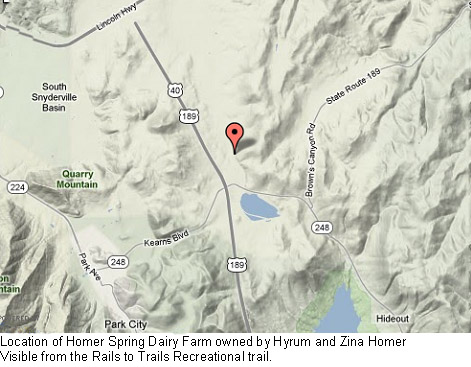
Wilford W. Snyder was Bishop from March to August 1924.Parley’s Ward was disorganized in August 1924.A change had occurred. The saw mills were no longer here for employment.The land and climate was good for dairy cattle and livestock, but to graze large herds it took a lot of acreage.So, the small landowners sold and moved elsewhere.The total population in 1930 was 125, only a percentage of these being L.D.S.The L.D.S. members were asked to combine with Park City, who had by now a strong membership.Many landowners didn’t live here, but lived in Salt Lake City, maybe bringing families “up” for the pleasant summer.Wilford Snyder, during the years of 1924-1973, was very active.He went on a mission to England. While there he converted Rose Lincoln, who later became his wife, and her mother and sister Maud Lincoln.Maud Lincoln married Wilford’s brother, David Snyder.These two brothers lived in the old Snyder homes (which were located where Highway 224 runs by Snyder’s Mill Subdivision). Wilford lived across the highway from David.
Rose Snyder was on the Summit Relief Society Stake Board as a teacher from 1934 to 1941, at which time she, Wilford, and family moved to California, remaining active members of the church all their lives.
David Stockwell Snyder, born the 1st of April1867, died on January 1, 1941, leaving his wife, Maud Lincoln Snyder, and the only living Snyder in the area, as they had had no children. Maud supported herself, alone, but loving and kind neighbors helped her whenever she would allow them to do so. She was alive and living in David’s father, Ephraim Snyder’s home today (1979). Maud was born on 27 December 1889 in Milnthorpe, Levens, England.She married on 27 November 1913 in Parley’s Park, Summit, Utah.Maud died around 1996. Her property (4 acres) is now owned by David Evans.
1929 – The stock market crashes. Silver King stock plummets from $12.87 to $6.50 in one year.; Park Con from $2 to 27 cents. A rope tow is installed at Snow Park (now Deer Valley).
1930 – A ski jump is built on the Creole mine dump. Downhill skiers are few and skiing is mostly a spectator sport. Through the continuing efforts of Strand, Ecker, and later S. Joseph Quinney, Ecker Hill in Pinebrook became the site of national ski jumping tournaments to 1949.
1931 – Alf Engen set a world record at Ecker Hill by jumping 247 feet. In all, Engen set five world records at Ecker Hill. Spectator crowds grew from 2,000 to over 8,000.
1934 – Charles F. Gillmor and wife Sarah Hanson Gillmor, along with their seven children, struggled to create a sizable sheep herd. After their parents divorce in 1921, the four sons, Charles F. Jr, Edward Leslie Gillmor, Ralph, and Stephen (Stephen T. Gillmor, Jr. 2/28/1927 to 2/5/1988 md. Shirley Fay Olsen 1896-1981, md Sarah Hanson) started the Gillmor Brothers Livestock Company, competing with other local sheepmen, the Bertanole’s and the Jeremy’s. The land holdings they had acquired from bankrupt neighbors created land wealth for the family in Round Valley and other Summit County areas. Florence Jane Gillmor 12/11/1918 to 10/18/2009.
1935 – Works Progress Administration (WPA) and other federal programs improved roads, schools, and public facilities in Summit County.
1936 – The town’s first Winter Carnival is a success, with more than 500 skiers arriving in Deer Valley on the ski train – a four-hour journey from Salt Lake City.
1938 – The road in Parley’s Canyon is improved and designated U.S. Highway 40 from Salt Lake City through Kimball’s Junction, at Silver Creek Junction making a turn to the south heading in the direction of Midway and Heber City.
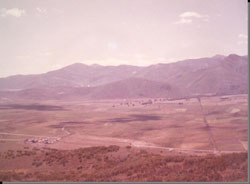
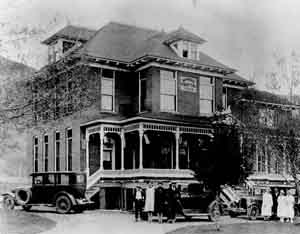
1940’s Miner’s Hospital near PCMR.
1941– December 7th, Pearl Harbor is attacked. Subsequent gas rationing prohibits travel to the Ecker Hill site.
Marie Rasmussen enlarged their store and added a small restaurant know as the “Welcome Inn Cafe” for years on Highway 40.On December 8, 1941Selma Rasmussen married James Kilby (1921-2009), a local judge (1961-1987), a charter member of the Summit County Planning Commission, and prominent citizen in Park City and Snyderville. They had to rebuild because of the Interstate Freeway 80 came through their property, which Chris had settled. They built a house located south of I-80 until around 2002 when it was razed for a new development.
Jim Dahl built Hi-Ute Ranch, and had a large piece of land fanning south into the mountains, which was later sold to Otto and Paul Buehner.
1946 – The first lift is installed at Snow Park (now Deer Valley). Mining prices continue to drop.
1949 – On July 1, the mines shut down, putting 1,200 miners out of work.
1950 – Construction of Interstate 80 forced the Pace family to abandon their “Big House” and 1,200 acre farmstead in a move to Wanship or Silver Creek (on Whileaway Road) after nearly 150 years of operation.
1951 – Park City is included in a book called “Ghost Towns of the West” indicating no population. There are actually 1,150 “ghosts” in town at this time.
1954– People are leaving town. Welsh, Driscoll and Buck’s department store closes after 50 years.
1957– Leland S. Swaner purchases the Spring Creek Angus Ranch that he continued to operate for the next 35 years. Originally constructed in the late 1800s, the ranch was located on the north side of the roadway, complete with a barn and other ranch buildings.
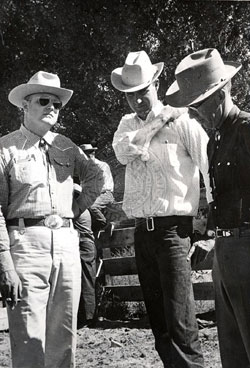
1958 – United Park City Mines looks to diversify and starts a feasibility study to begin the Treasure Mountain Resort (now Park City Mountain Resort).
1960– Amidst growing public interest in participatory alpine skiing, promoters briefly attempted to revive ski jumping at Ecker Hill.
1963 – Park City qualifies for a federal loan from the Area Redevelopment Agency. The government gives $1.25 million and, with other contributions, a total of $2 million is used to start Treasure Mountain Ski Resort in old town Park City. A gondola, a chairlift and 2 J-bars are installed. A lift pass costs $3.50 and there are almost 50,000 skier days logged that first year.
1968 – Park City West Ski Area (now Canyons Resort) opens, lift tickets are $4.50.
1969 – Snow Park closes.
1969-1973 – Interstate-80 is constructed through Kimball’s Junction.
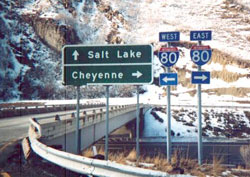
1970 – First Park City Art Festival debuts on Main Street.
1971 –Royal Street Development Company started its $100 million master plan for Deer Valley Ski Resort above Park City.
1975 – Park City West Ski Area is bought by new owners, Jack Roberts [his father Harold Roberts, and wife Marilyn] and Harold Babcock and the name is changed to ParkWest because of confusion about association with then Park City Resort.
1976 – Kimball Art Center, in the old Eley Garage at 638 Main Street, opens its doors with two galleries, a gift shop, and classrooms.
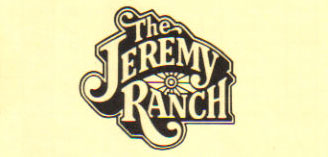
Around 1977 a Salt Lake optometrist, Gerald Hawley “Jiggs” Bagley (1922-1999), developed interest in the 12,500 acres east of Parley’s Summit in Summit County known as The Jeremy Ranch. Jiggs paid $5 million for the land, $3 million to build the clubhouse, infrastructure for another $6 million. After a ground breaking ceremony on May 1979, Jiggs hired renown golfer Arnold Palmer to design and develop an award winning 18-hole golf course on this land. Jiggs then promoted the Jeremy Ranch ShootOuts (later Shootdown) events beginning in 1982 and brought PGA Tournaments to the Moose Valley basin. He was responsible for bringing world class golfers and tennis players to Summit County and to Salt Lake City. The ShootOut had an eleven year run. Around that time Jiggs was the developer of Canyon Racquet Club, was a 50% owner of the Utah Jazz basketball team, held a large interest in Red Pine Condominiums at the base of ParkWest (now Canyons) Ski Resort, was owner/and or developer of Hi-Country Estates in west SLC, and had other real estate ventures.
1978 – On Valentine’s Day, Park City is without a working mine for the first time in over 100 years. Despite a rally in the early 80s, mining will be over by 1982. A skeleton crew keeps the water pumped out and the mines open in case the price of metals increases dramatically1979 – The 1904 Miners Hospital, threatened with demolition, is moved from its site near the base of the Park City Ski Area [where Shadow Ridge now sits] to the City Park for its new use as the City’s public library. The Pace family sold property to the developers of Silver Creek Commercial Center at 6440 N. Highway 40 (189).–Utah Power Company built a large substation near Quinn’s Junction.The Flinders Mountain Meadow Ranch of today had been Pace property, they had sold to A.E. Carter, this area being an important dairy producer. Flinder’s cattle would graze along both sides of Highway 224.1980 – KPCW, Summit County’s public radio, goes on the air.
1981 – Deer Valley Resort opens at the site of the old Snow Park area. The United States Film and Video Festival, highlighting independent films, opens in January for the first season in Park City. The festival has since become the Sundance Film Festival.– Union Pacific Railroad discontinued Service to Park City. The Park City Train Station was sold to Randy and Debbie Fields. Later it was sold to Robert Redford for his “Zoom” Restaurant. Thirty miles of the railroad track line property was sold to become a public Rails to Trails. The rails were removed and the rail bed upgraded for public use by bikers, hikers, dog walkers, and in winter, cross country alpine skiing.– Geneva Rock Company built a concrete batch plant near Quinn’s Junction.1982 – After extensive renovation on the old Miners Hospital, a human chain forms a “book brigade” to move the thousands of books in the collection at the original library on Main Street to its new location.
1983-1984 – Florence Gillmor (plaintiff) and Edward Gillmor owned equal shares of some 33,000 acres of land, which was used for cattle grazing. Edward was using the property exclusively. Florence demanded to be given access to the land to graze her livestock and that Edward alter his use to allow her to do so. Edward did not respond and continued his use of land at its maximum capacity. Edward asserted that he had invited Florence to use the land, but he never made any accommodation for her to do so even though any additional grazing would have injured the land. Edward admitted that if Florence had tried to use the land, he would have sought an injunction to prevent damage to the land. Florence claimed an ouster and sued to recover one-half of the rental value of the property. The trial court found that Edward had ousted Florence and awarded her half the rental value of the land. Edward appealed, arguing that the trial court erred in finding an ouster, that the award was excessive, and that he should be compensated for a fence he built and a ditch he had dug.
1985 – Jerry Gilomen buys out Harold Babcock’s share of the resort and takes over operations of ParkWest, which now has seven lifts.1987 – Silver Creek Water Reclamation Facility installed a large diameter pipeline along Kearns Boulevard and along the west side of Highway 40 in Silver Creek Valley to the processing plant at the entrance to Silver Creek Canyon.
1992 – The Union Pacific railroad tracks were removed from Atkinson and the 30 miles between Park City and Echo. The rail bed was left following the Silver Creek , runners, hikers, dog walkers, and bicycle enthusiasts can now enjoy this pleasant path. The Historic Union Pacific Rails to Trail has been open since 1992. The fairly level topography of the trail rises along the old railroad bed at an average grade of 2 percent with a maximum grade of trail 3 percent. Lowest elevation is 5200 feet and the highest elevation is 6900 feet at Park City. The average width of the trail bed is over 12 feet. Access to the Rails to Trails is available along many points of its length.
1993 – The Spring Creek Angus Ranch Partnership donates 190 acres of land in memory of Leland Swaner, establishing the Swaner Memorial Park Foundation.
1993 – Park City residents witness the heaviest snowfall in 10 years. The public library moves from the Miners Hospital into the old high school [Carl Winters H.S.] at 1255 Park Ave.
— The Utah Winter Sports Park (now The Olympic Park) opens. Park City is fast becoming a premier ski town. The town is home to not only the United States Ski and Snowboard Association, but also the venue for America’s Opening each November, the first World Cup ski event of the season to be held in the USA.
1993 – The Spring Creek Angus Ranch Partnership donates 190 acres of land in memory of Leland Swaner, establishing the Swaner Memorial Park Foundation.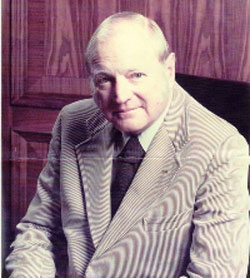
1994 – The Gillmor family sold 210 acres of their Silver Creek property to Deer Creek Development for $7.3 million.
1995 – Salt Lake City is awarded the 2002 XXIX Winter Olympic Games with Deer Valley property owner Mitt Romney as CEO. More than 40% of the events were held in Park City at the Utah Olympic Park, Deer Valley, and Park City Mountain Resort. The Utah Olympic Park is located in Summit County off Highway 224 [Olympic Highway], and was the venue for a number of Olympic events, including ski jumping, luge, bobsled and skeleton sled races.
1995 – ParkWest new owners, Kenny Griswold and Michael Baker, renamed this resort Wolf Mountain after a public contest to choose a new name. All of the runs are named after endangered species. Wolf Mountain was the first resort in Park City to allow snowboarding.
1996-1999 – The Swaner Nature Preserve grows to more than 1,000 acres, thanks to the donation of seven additional parcels of land.
1997 – Wolf Mountain is purchased by American Skiing Company and is renamed The Canyons Resort. The Canyons embarks on phase 1 of a $500 million expansion plan. Initial resort acreage: 1,400 acres. IMA [Iron Mountain Associates – Walt Brett and Keith Kelly] planned a development of a low density, large lot residential subdivision on the IMA/ASC Property to be known as The Colony. Six hundred fifty acres in White Pine Canyon were recently acquired by ASC from the George and John Condas Family, referred to as “The ASC/Condas Property.”. The Colony includes 4,600 acres, including just over 300 homesites, and 9 of The Canyons 19 ski lifts are located within The Colony.
1997 – December – The Canyons opens for its inaugural season. New amenities include the Red Pine mid-mountain lodge, the Flight of The Canyons Gondola, Saddleback Express, Snow Canyon Express, and the High Meadow Lift. Total acreage grows to 2,200 acres.
1998 – December -The fabled Ninety-Nine-90 peak, Utah’s most dynamic extreme terrain, opens bringing Canyons resort acreage to 2,800 acres.
2000 – September – The Canyons Cabriolet is installed, allowing access from the lower parking lot to the Resort Village.
2001 – The Canyons installs the Day Break lift. The resort’s acreage hits 3,500 acres making The Canyons Utah’s single largest ski and snowboard resort and the 5th largest resort in the United States.
2001 – Federal Wetland Reserve Program easement is established to protect 533 acres of critical wetland habitat on the east side of the Swaner Nature Preserve. Over the next three years, ponds are re-created, agricultural ditches are filled and streams are restored, returning the wetlands to their natural condition.
2002 – The XXIX Winter Olympic Games are hosted by Utah, with Deer Valley property owner Mitt Romney as CEO, and Park City is the party epicenter of the Olympics!
2003 – Ralph W. and Diane Wallin Dairy Farm is purchased (now known as the Swaner Farm), adding 107 acres to the Swaner Preserve. Ralph Wallin served as a Summit County Commissioner for many years.
The Swaner Nature Preserve boundaries are finalized. The preserve parcels began in 1993 with the Spring Creek Angus Ranch Partnership donation of 190 acres in memory of Leland Swaner. In 1996 Ranch Place Associates donated 83 acres. In 1997 Jack and Helen Jarman donated 21 acres. Double “M” Partnership and Jim Lewis donated 210 acres. Black Hawk Ranch donated 375 acres. 1998 an anonymous conservation buyer donated 94 acres. in June another 22 acre site is donated. in 1999 a donation of 120 acres is added. in 2001 a Federal Wetland Reserve Program easement is established on 533 acres of critical wetland habitat on the east side of the Preserve.
2007 – Standley Pace, the 80 year old son of Alma Pace, sold the last commercial dairy operation in the Park City area. This marked the end of nearly 150 years of continuous dairy farming by the Pace family in Silver Creek Valley.
 2008 – April – The remains of the early Mormon leader and Park City name-sake will be moved from Van Buren, Arkansas to S.L.C., Utah later this month. Parley Parker Pratt was murdered 151 years ago in Arkansas. Pratt was chosen by Joseph Smith as one of the first Mormon apostles c. 1831. In 1847 Pratt traveled through our area and then returned to lay his stake. Our local elementary school, Parley’s Park Elementary School, Parley’s Canyon, Parley’s Summit, and Park City (originally Parley’s Park City) were named for him. Also note the original recorded parcels in this area begin with the initials “PP” for Parley’s Park. While on a mission for the church to the southern states, Pratt was accused by Hector McLean in a lawsuit for causing the estrangement in McLean’s marriage to Eleanor McLean, who became Pratt’s 12th wife. Although Pratt was exonerated by the court (McLean had been in the gold fields of California for a protracted period of time), McLean and two accomplices pursued Pratt to Alma, Arkansas, where they fired at and stabbed him. Pratt died May 13, 1857. One of Pratt’s dying wishes was for his body to be returned to Utah.
2008 – April – The remains of the early Mormon leader and Park City name-sake will be moved from Van Buren, Arkansas to S.L.C., Utah later this month. Parley Parker Pratt was murdered 151 years ago in Arkansas. Pratt was chosen by Joseph Smith as one of the first Mormon apostles c. 1831. In 1847 Pratt traveled through our area and then returned to lay his stake. Our local elementary school, Parley’s Park Elementary School, Parley’s Canyon, Parley’s Summit, and Park City (originally Parley’s Park City) were named for him. Also note the original recorded parcels in this area begin with the initials “PP” for Parley’s Park. While on a mission for the church to the southern states, Pratt was accused by Hector McLean in a lawsuit for causing the estrangement in McLean’s marriage to Eleanor McLean, who became Pratt’s 12th wife. Although Pratt was exonerated by the court (McLean had been in the gold fields of California for a protracted period of time), McLean and two accomplices pursued Pratt to Alma, Arkansas, where they fired at and stabbed him. Pratt died May 13, 1857. One of Pratt’s dying wishes was for his body to be returned to Utah.
[Later in 2008 Arkansas denied the family wishes to move Pratt’s remains to Utah.]
2008 – July- The Canyons was purchased from American Ski Company by Talisker, a privately owned real estate and development company based in Toronto, Canada, said Jack Bistricer, CEO and Chairman of Talisker who offered $100 million for the resort last July, but Fair said recent capital improvements, additional water rights and interest expenses raised the price to $123 million.
2008 – Swaner Preserve EcoCenter Grand Opening. The organization’s name legally changes to the Swaner EcoCenter, encompassing the EcoCenter, Swaner Preserve, Swaner Trails and Swaner Farm.
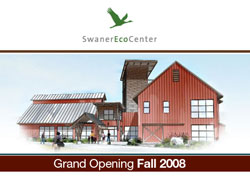
2010 – Obituary for Beverly Jean Felton Pace 1932-2010. Followed shortly by death, her husband Standley Pace 1928-2010 Obituary.
2010 – Swaner Preserve and EcoCenter makes largest gift in Utah State University’s history. The gift transfers the Swaner Preserve and EcoCenter to USU ownership and oversight. Swaner’s mission to preserve, educate, and nurture will continue with increased programming, research opportunities, and satellite education.
2011 – March – A group of business entities led by Kenneth J. Abdalla, 48, sharing the same Southern California address in Pacific Palisades has quietly snapped up four Main Street properties since March, a buying spree that quickly made the umbrella owner one of the most important players in Park City since Randy and Debbie Fields. According to Summit County property records, the transactions included: -the Imperial Hotel that went to a business entity called Imperial Hotel Resort Group LLC. (The deal was finalized June 2, 2011); -a majority of the units in the Silver Queen Hotel; -a building at 692 Main Street; and -a vacant lot at 205 Main Street.
 2011 – July 22 – Wolf Mountain sells to newcomer, Kenneth James Abdullah Joe Wrona, a Park City attorney who represents the buyer, Ken Abdullah (shown in 2012 photo with wife Kay ‘Kitty’ C. Stoneburner), said the business entity is known as Canyon Mountain Partners, LLC. It purchased 100 percent of the ownership interests in Wolf Mountain Resorts, which included the interests of Kenny Griswold and Michael Baker, Wrona said. Terms were not disclosed. The Abdullah firm recently closed on the purchase of the Fairway Springs Ski & Golf Villas development, which is under construction at the base of Canyons, scheduled to open summer 2013. Amanda Murphy-Walker (SLS-038) works as the Abdullah’s administrative assistant.
2011 – July 22 – Wolf Mountain sells to newcomer, Kenneth James Abdullah Joe Wrona, a Park City attorney who represents the buyer, Ken Abdullah (shown in 2012 photo with wife Kay ‘Kitty’ C. Stoneburner), said the business entity is known as Canyon Mountain Partners, LLC. It purchased 100 percent of the ownership interests in Wolf Mountain Resorts, which included the interests of Kenny Griswold and Michael Baker, Wrona said. Terms were not disclosed. The Abdullah firm recently closed on the purchase of the Fairway Springs Ski & Golf Villas development, which is under construction at the base of Canyons, scheduled to open summer 2013. Amanda Murphy-Walker (SLS-038) works as the Abdullah’s administrative assistant.

